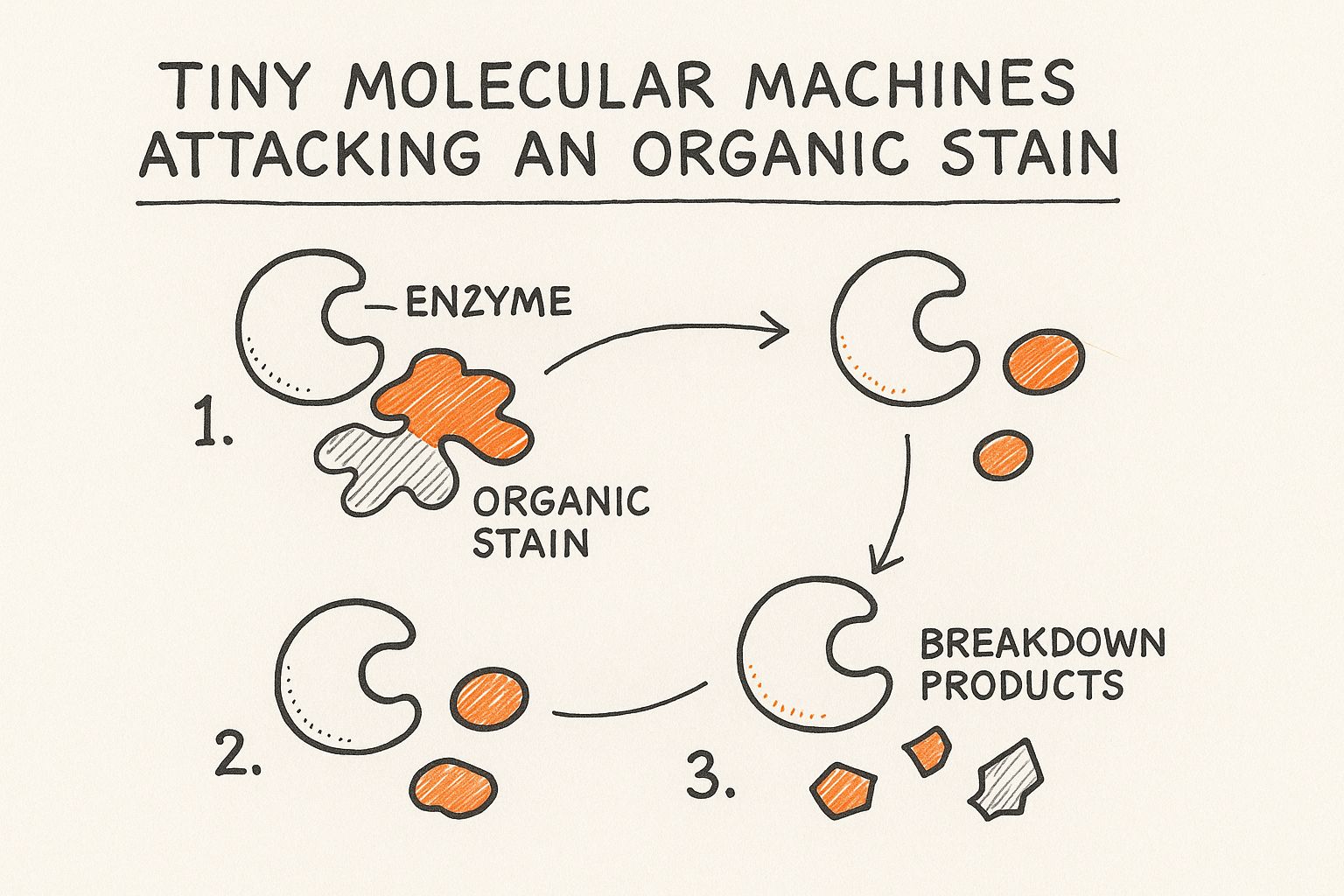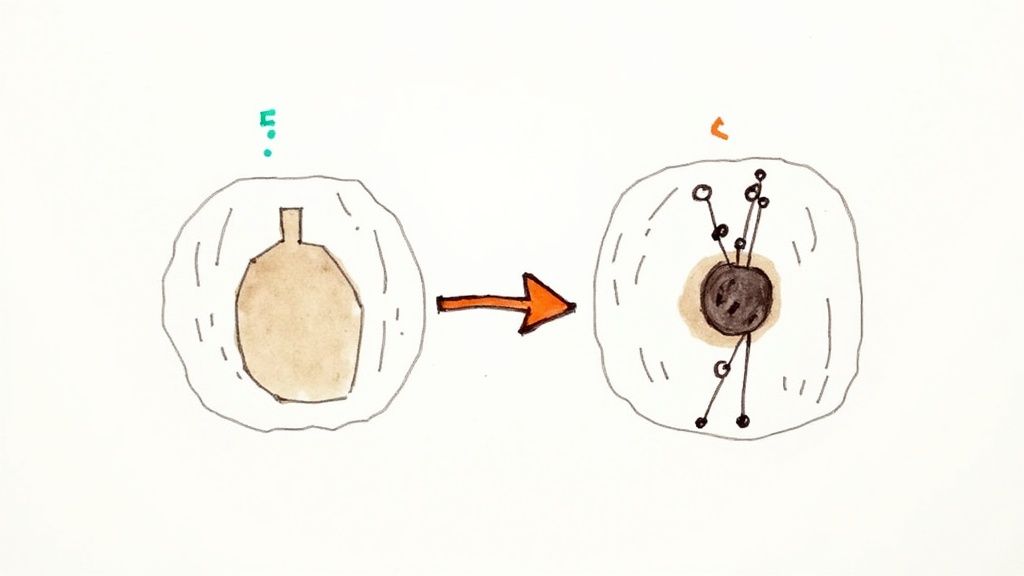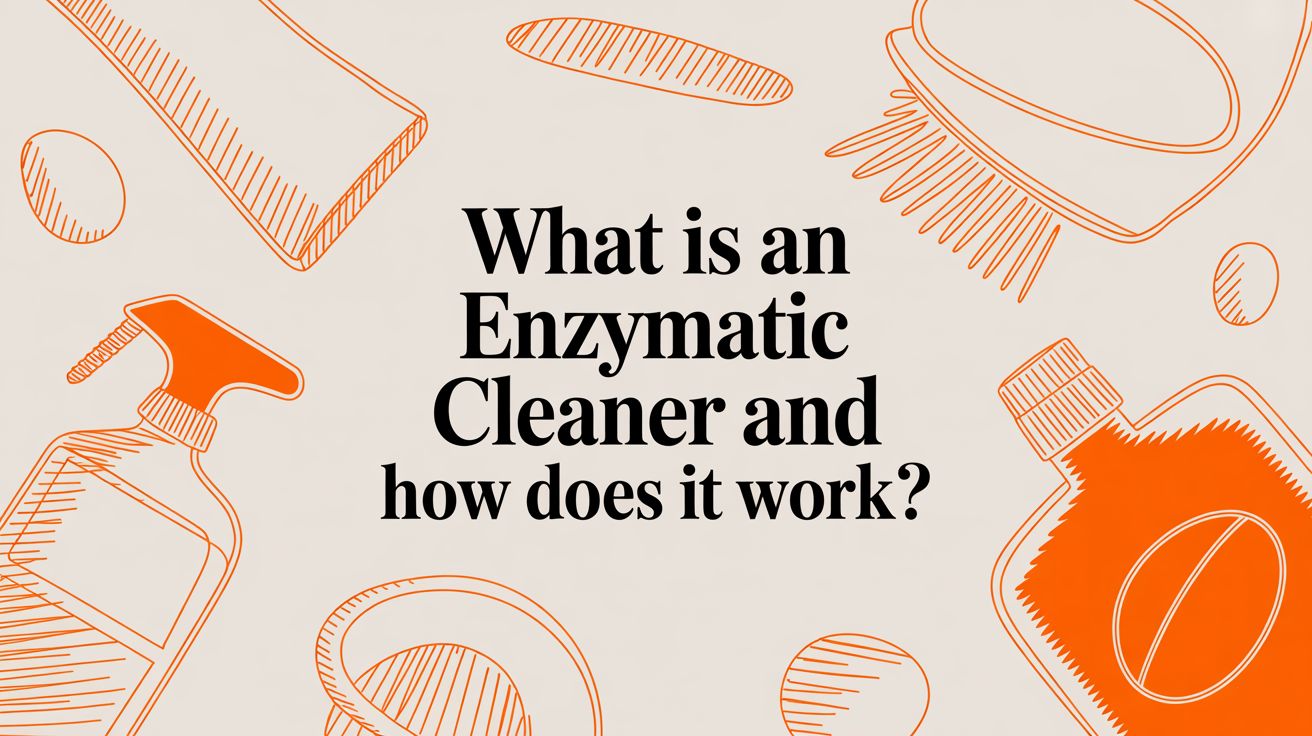Ever wonder what makes an enzymatic cleaner different from your typical all-purpose spray? It’s a specialized cleaning solution that ditches harsh chemicals in favor of natural proteins called enzymes.
Instead of just lifting grime off the surface like a regular soap, these cleaners get to the root of the problem. They actually digest the organic stuff causing the stain, making them absolute powerhouses against tough messes like pet accidents, grass stains, and grease.
The Secret Science Behind Enzymatic Cleaners
So, what’s going on at a microscopic level? Think of an enzymatic cleaner as a crew of highly specialized workers. Each worker—an enzyme—has only one very specific job.
One type of enzyme is programmed to break down proteins. Another is built to target fats, while a third is laser-focused on starches. This "divide and conquer" strategy is what makes them so incredibly effective.
Traditional chemical cleaners often use corrosive, heavy-hitting ingredients to dissolve stains. This can work, but it often comes at the cost of damaging the surface you're trying to clean, not to mention the strong fumes they leave behind.
Enzymatic cleaners work differently. It's a subtle but powerful biological process. They don’t just clean the surface; they completely dismantle the stain molecule by molecule, turning complex organic messes into simple, water-soluble bits that wipe away with ease. This process eliminates not just the stain, but the odor source, too.
The real magic is that enzymes don't just mask odors or wipe away surface dirt. They digest the organic material causing the problem, ensuring the stain and the smell are gone for good, not just temporarily hidden.
How Enzymes Target Stains
To really get why they work so well, you need to know which enzyme tackles which mess. Different formulas use specific blends to handle various cleaning challenges.
- Protease: This is your protein-eater. It’s the perfect choice for breaking down stains from blood, pet urine, feces, vomit, and grass.
- Lipase: As a fat-dissolver, lipase is your go-to for anything greasy or oily. Think kitchen grease, food spills, and even some makeup stains.
- Amylase: This one targets starches. It's highly effective against carbohydrate-based stains like sauces, ice cream, gravy, and baby food.
This infographic gives you a great visual of how these tiny molecular machines attack and break down a stain.

As you can see, the process isn’t about brute force or scrubbing. It’s about a targeted chemical reaction that dismantles the stain from the inside out.
Common Enzymes and the Stains They Target
To make it even easier to understand, here's a quick cheat sheet for the most common enzymes you'll find in these cleaners and what they're designed to destroy.
| Enzyme Type | Targets This Type of Stain | Common Examples |
|---|---|---|
| Protease | Proteins | Pet urine, blood, vomit, grass, food |
| Lipase | Fats & Oils | Grease, body oils, greasy food spills |
| Amylase | Starches & Carbohydrates | Gravy, chocolate, baby food, ice cream |
| Cellulase | Cellulose | General grime, mud, softening fabrics |
This table helps show just how specific these enzymes are. Having the right tool for the job makes all the difference, and in the world of cleaning, that means matching the right enzyme to the right stain.
How Enzymes Actually Eliminate Stains
To really get what an enzymatic cleaner is, you have to look at what's happening on a molecular level. This isn't about brute force scrubbing. It’s a precise, biological process that literally takes the stain apart piece by piece.
Think of it like a highly specialized lock-and-key system.
Every enzyme in the bottle is a "key" with a very specific shape. That key is built to fit perfectly into a specific type of stain molecule—the "lock." For example, a protease enzyme is designed only to connect with protein molecules, like the ones in pet urine, blood, or food spills. It will completely ignore everything else, like fats or starches. This is what makes them so ruthlessly efficient.

Once that enzyme "key" finds its matching stain "lock," it triggers a chemical reaction. This reaction acts like microscopic scissors, chopping up the big, complex stain molecule into tiny, simple pieces. These little particles are water-soluble, which is just a fancy way of saying they can no longer cling to your carpet fibers and can be easily blotted or rinsed away.
The Four Stages of Stain Digestion
The whole process happens in a few distinct stages. Understanding this really shows why enzymatic cleaners blow traditional soaps out of the water, since soaps just lift surface grime and often leave a sticky mess behind.
- Application and Activation: First, you have to apply the cleaner to the stain—and don't be shy about it. The moisture in the liquid "wakes up" the dormant enzymes and tells them it's time to get to work.
- The Breakdown (Dwell Time): This is the most important part, and where most people go wrong. The enzymes need time to hunt down their target molecules and start breaking them down. This is called dwell time. Rushing this step is the biggest mistake you can make. For really tough messes, this can take anywhere from 15 minutes to several hours.
- Digestion and Conversion: During the dwell time, the enzymes are busy "eating" the stain. They're converting all that nasty organic stuff into basic components like carbon dioxide and water.
- Final Removal: Once the enzymes have finished their meal, the stain's structure is completely gone. All that’s left is a residue that you can easily blot up with a towel, leaving no trace of the original mess.
This whole process is a game-changer for pet owners. When you're dealing with an accident, you have to break down the organic compounds completely, or that smell will keep coming back. For a more detailed guide, check out our article on the best way to clean up after a pet accident.
Here's the bottom line: an enzymatic cleaner doesn't just cover up a stain or mask an odor. It biologically eradicates the source. That means the problem is gone for good and won't suddenly reappear a week later.
Why Choose Enzymes Over Traditional Cleaners?
When you’re staring down a nasty stain on your carpet, it’s easy to think you need the harshest, most aggressive chemical you can find. But what if I told you a gentler, smarter approach is actually far more effective? This is where enzymatic cleaners come in, and they completely change the game compared to old-school, harsh chemical cleaners.
Traditional cleaners, think bleach or ammonia, are like a sledgehammer. They work by using brute force to dissolve or bleach a stain on the surface. Sure, the stain might look like it's gone, but the actual organic gunk is often still buried deep in the carpet fibers, upholstery, or even grout. You’ve only hidden the problem, not solved it.
Enzymatic cleaners are totally different. Instead of a chemical assault, they use biology to get the job done. Think of them like microscopic Pac-Men, programmed to find and devour the specific organic matter causing the stain and odor until there’s literally nothing left. They dismantle the stain from the inside out.
A Safer Choice for Your Home
One of the biggest wins for enzymatic cleaners is safety. Let’s be real, many conventional cleaning products are loaded with corrosive chemicals that aren't great for you, your kids, your pets, or even the surfaces you're cleaning.
- Non-Toxic Formulas: Most quality enzymatic cleaners are pH-neutral and don't contain harsh, toxic chemicals. This makes them a much safer bet for homes where kids and pets spend a ton of time rolling around on the floor.
- No Harsh Fumes: You know that overpowering smell from bleach or ammonia-based products that makes you want to open every window? Enzymatic cleaners work their magic without pumping your home full of irritating, toxic fumes.
Here's the bottom line: chemical cleaners blast everything in their path, including your carpet fibers and the air you breathe. An enzymatic cleaner is a targeted weapon that only attacks the organic stain, leaving everything else untouched and unharmed.
The Eco-Friendly Advantage
Beyond being safer for your family, enzymatic cleaners are a much more responsible choice for the planet. Their main ingredients are proteins, which are completely biodegradable. Once they go down the drain, they break down into simple, harmless stuff like carbon dioxide and water.
This is a massive contrast to harsh chemical cleaners that can stick around in the environment and pollute our waterways. When you choose an enzymatic cleaner, you're picking a solution that works with nature, not against it.
People are catching on, and the demand for greener cleaning solutions is exploding. The global enzymatic cleaning market is already a multi-billion dollar industry and is expected to hit roughly USD 31,038.4 million by 2035. This boom is all thanks to people like you wanting products that are effective and sustainable. You can explore the full market analysis to see just how fast this trend is growing.
Ultimately, choosing enzymes isn't just a better decision for one tough stain; it's a smarter, safer, and more sustainable choice for your entire home.
Where to Use Enzymatic Cleaners in Your Home

Knowing the science is great, but the real proof is in the pudding. Where do these biological powerhouses actually work best? The truth is, they're incredibly versatile and ready to tackle some of the most frustrating messes you can imagine, from soft fabrics to hard surfaces.
The absolute key to success is giving the enzymes enough dwell time to do their job. This isn't your typical spray-and-wipe-in-five-seconds cleaner. The enzymes need time to find and digest the organic mess causing the stain or odor. Depending on how bad the spot is, this could be anywhere from 15 minutes to a few hours.
Rushing this step is the single biggest mistake people make, and it almost always leads to disappointing results.
Tackling Carpet and Upholstery Stains
Your carpets and furniture are basically magnets for organic stains, especially if you have kids or pets. This is where enzymatic cleaners really prove their worth. They don't just clean the surface; they dive deep into the fibers to completely eliminate the source of the problem.
Here’s how they handle common messes:
- Pet Urine and Accidents: This is the ultimate test, and enzymatic cleaners pass with flying colors. They break down the uric acid crystals in pet urine that create those impossible-to-get-rid-of smells. For a deeper dive into this specific challenge, check out our guide on how to get rid of pet odor in carpet.
- Food and Drink Spills: Spilled some wine, coffee, or greasy food? An enzymatic cleaner with a mix of protease, lipase, and amylase will dismantle the proteins, fats, and starches, leaving no trace behind.
- Blood or Grass Stains: These are protein-based stains, and protease enzymes digest them with ease. You can lift these stains right out of fabrics without resorting to harsh scrubbing or bleach.
A critical tip to remember is to never mix enzymatic cleaners with bleach or other harsh disinfectants. The high pH and oxidizing agents in bleach will deactivate, or "denature," the enzymes, rendering them completely useless.
Eliminating Odors and Buildup
Beyond just the stains you can see, enzymatic cleaners are experts at destroying the invisible sources of bad smells and grimy buildup. Their power to digest organic matter makes them a fantastic tool for all sorts of jobs around the house.
For instance, the enzymatic cleaning market exploded during the recent pandemic, as hospitals and clinics relied on them to ensure medical instruments were truly sterile. The global market, which was over USD 15.54 billion, is expected to soar past USD 24.13 billion by 2035. This huge demand is driven by the need for powerful, yet eco-friendly, cleaning solutions.
That same powerful technology is perfect for tackling household chores like:
- Laundry: Add about a cup to your wash cycle to break down sweat, body oils, and stubborn food stains. Your clothes will come out fresher and cleaner than ever.
- Drains: Forget corrosive chemicals. Pouring an enzymatic solution down your drains helps it digest the gunk and biofilm that cause clogs and foul odors.
- Trash Cans: A quick spray-down gets rid of the source of garbage smells instead of just covering them up with a temporary fragrance.
How to Choose the Right Enzymatic Cleaner
Walking down the cleaning aisle can make your head spin. With so many bottles promising miracles, how do you pick the right enzymatic cleaner? It's easy to feel overwhelmed, but the secret is pretty simple: read the label and know what kind of mess you're fighting.
Choosing the right formula is the difference between a stain disappearing for good and a frustrating afternoon of scrubbing. The first step is to play detective and figure out exactly what you’re trying to clean. Is it a protein-based accident from a pet, or a greasy food spill from last night's dinner? Knowing your enemy helps you pick the right weapon.
An all-purpose cleaner might handle some surface grime, but for a specific, stubborn problem like a pet accident, you absolutely want a specialized formula. These products pack a much higher concentration of the exact enzymes needed to get the job done right.
Decode the Label to Find Your Match
The best enzymatic cleaner is the one formulated for your specific headache. Think of it like a prescription—you wouldn't take just any medicine for an illness, and the same logic applies here. To find the perfect match, you need to learn how to read the ingredients list.
- For Protein Stains (Pet Urine, Blood, Vomit): You need to see protease on that label, preferably high on the ingredients list. This enzyme is the champion at digesting protein-based messes and is non-negotiable for truly getting rid of pet odors instead of just masking them.
- For Greasy & Oily Stains (Food, Body Oils): The enzyme you're looking for here is lipase. It's a fat-and-oil-busting powerhouse, making it perfect for those kitchen spills on the rug or the oily spot on the sofa where everyone rests their head.
- For Starch-Based Messes (Sauces, Ice Cream): A cleaner containing amylase is your best friend for these carbohydrate-heavy stains. It goes to work dismantling the sticky, starchy compounds.
Getting the product right is especially crucial when you're dealing with a tough pet stain on your carpet. If you need more specific advice, we have a detailed guide on what is the best carpet spot cleaner for pets.
Consider the Formula and Format
Beyond just the type of enzyme, think about how you'll be using the cleaner. Sprays are super convenient for quick, on-the-spot treatments. Concentrates, on the other hand, usually offer a better value if you're tackling larger areas or doing some heavy-duty cleaning like mopping floors.
The concentration of the enzymes themselves also makes a huge difference. A higher-quality product will almost always have a denser blend of active enzymes, which means it will work faster and more effectively.
It's no surprise that more and more people are turning to these cleaners. The enzymatic cleaning market is expected to balloon to USD 30.75 billion by 2035, which tells you that homeowners are catching on to how well these targeted, biological solutions work. This boom is being driven by new multi-enzyme formulas designed for very specific household messes, a trend you can learn more about from market growth reports.
Got Questions About Enzymatic Cleaners?
Even after getting the basics down, you probably still have a few questions rolling around in your head. That's completely normal. Anytime you bring a new type of product into your home, you want to look at it from all angles to make sure it's the right choice for your family, your pets, and your cleaning needs.
Let's clear the air and tackle some of the most common uncertainties people have. Getting these answers will give you the confidence to use these little biological powerhouses safely and effectively, so you can see for yourself why they work so well. This is about cleaning smarter, not just harder.
Are Enzymatic Cleaners Really Safe for My Pets and Kids?
This is usually the first question on everyone's mind, and for good reason. The great news is that, yes, a high-quality enzymatic cleaner is a much safer bet than its traditional chemical cousins. Because they use natural proteins to do the dirty work instead of harsh, corrosive chemicals, they don’t fill your home with the toxic fumes you get from products like bleach or ammonia.
Most formulas are pH-neutral and non-toxic, which is a huge sigh of relief for any parent or pet owner. But remember, it's still a cleaning product.
- Always read the label: Look for products that specifically say they are non-toxic and biodegradable.
- Store them properly: Just like any other cleaner, keep them stored safely out of reach of curious kids and pets.
The bottom line is that while they are a significantly safer choice for your home, you still need to practice common-sense storage.
How Long Do I Have to Wait for It to Work?
This is where you need to shift your thinking away from the "spray-and-wipe-immediately" habit we've all learned from chemical cleaners. Enzymes aren't instant. Think of them as tiny biological workers who need time to do their job right. This waiting period is called dwell time. Patience isn’t just a virtue here; it’s a non-negotiable part of the process.
For a fresh, minor spill, you might only need to let the cleaner sit for 15 to 30 minutes. But for the really tough jobs, you’ll have to give it a lot more time.
For deep-set problems, like old pet urine that has soaked through the carpet and into the padding, you may need to let the product sit for several hours or even overnight. Rushing this step is the single biggest reason these cleaners "fail" for people.
The enzymes need that extended time to find, latch onto, and completely break down all the organic gunk causing the stain and the smell.
Can I Use This Stuff on Any Surface?
Enzymatic cleaners are workhorses, but they aren’t a miracle cure for every single surface in your house. They do their best work on most water-safe materials where organic stains love to hang out.
Where They Shine:
- Carpets and area rugs
- Upholstery and mattresses
- Tile and grout
- Concrete and sealed wood floors
- As a laundry pre-treater for organic stains
But you do need to be careful with certain materials. Avoid using them on surfaces that could be damaged by moisture, like untreated hardwood, natural silk, wool, and some types of leather.
The golden rule is simple: always do a spot test. Before you go to town on a visible stain, spray a small, hidden area (like on the carpet inside a closet or the underside of a sofa cushion) to make sure it doesn’t cause any discoloration or damage.
Do Enzymatic Cleaners Go Bad?
Yes, they absolutely do, and this is a critical point that trips a lot of people up. Because the active ingredients are biological—the enzymes themselves—they have a shelf life. Over time, these proteins naturally break down and become useless.
Most enzymatic cleaners are good for about one to two years. Using an expired product is basically like spraying expensive water on a stain. The little "workers" are no longer active, so you won't get any of the stain-digesting magic.
To get the powerful results you're looking for, always check the expiration date on the bottle before you buy it or use it. A fresh, potent product makes all the difference.
When tough pet stains and odors on your carpet feel impossible to beat, it’s time to call in the professionals. At Citrus Carpet Cleaning Buford, we use specialized, low-moisture cleaning techniques that eliminate stains at their source without leaving behind sticky residues. Get your free, no-obligation "EXACT-imate" today by visiting us at https://citruscarpetcleaningatlanta.com.

